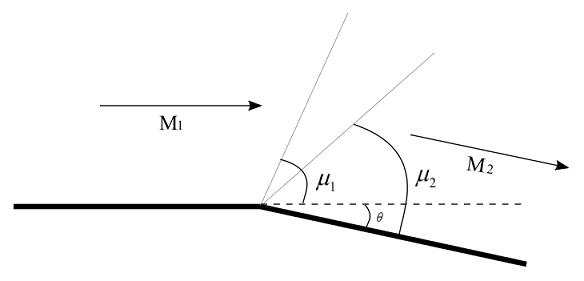The upstream Mach number, pressure and temperature of a supersonic flow over an expansion corner having deflection angle \(\theta =25^{^{\circ}}\) is \(M_{1}=2.2,\,p_{1}=0.8\,atm\) and \(T_{1}=360\,K\). Find the downstream Mach number, pressure, temperature, density , total pressure, total temperature, and the angles made by the forward and rearward Mach lines with local flow direction.
The upstream Mach number, pressure and temperature of a supersonic flow over an expansion corner having deflection angle \(\theta =25^{^{\circ}}\) is \(M_{1}=2.2,\,p_{1}=0.8\,atm\) and \(T_{1}=360\,K\). Find the downstream Mach number, pressure, temperature, density , total pressure, total temperature, and the angles made by the forward and rearward Mach lines with local flow direction.
Downstream Mach number can be calculated from Prandtl-Meyer function
\[\nu (M)=\sqrt{\frac{\gamma +1}{\gamma -1}}tan^{-1}\sqrt{\frac{\gamma -1}{\gamma +1}\left ( M^{2}-1 \right )}-tan^{-1}\sqrt{M^{2}-1}\]
For a Mach number of \(2.2\), \(\nu \left ( M_{1} \right )=31.73^{^{\circ}}\)
\[\theta =\nu \left ( M_{2} \right )-\nu \left ( M_{1} \right )\]
\[\Rightarrow \nu \left ( M_{2} \right )=\theta + \nu \left ( M_{1} \right ) = 25^{\circ}+31.73^{\circ}=56.73^{\circ}\]
for, \(\nu \left ( M_{2} \right )=56.73^{^{\circ}}\), Mach number \(M_{2}=3.389\)
From Isentropic flow properties for, \(M_{1}=2.2\)
\[\frac{p_{01}}{p_{1}}=10.69\] and
\[\frac{T_{01}}{T_{1}}=1.968\]
For, \(M_{2}=3.389\)
\[\frac{p_{02}}{p_{2}}=65.0798\] and
\[\frac{T_{02}}{T_{2}}=3.297\]
Total pressure and total temperature is constant through the expansion wave, so
\(p_{01}=p_{02}\) and \(T_{01}=T_{02}\)
Therefore,
\[p_{2}=\left ( \frac{p_{2}}{p_{02}} \right )\left ( \frac{p_{01}}{p_{1}} \right )p_{1}=\left ( \frac{1}{65.0798} \right )\left ( 10.69 \right )0.8=0.1314\,atm\]
\[T_{2}=\left ( \frac{T_{2}}{T_{02}} \right )\left ( \frac{T_{01}}{T_{1}} \right )T_{1}=\left ( \frac{1}{3.297} \right )\left ( 1.968 \right )360=214.886\,K\]
\[p_{2}=\rho _{2}RT_{2}\]
\[\Rightarrow 0.1314=\rho _{2}\left ( 287 \right )\left ( 214.886\,K \right )\]
\[\Rightarrow \rho _{2}=\frac{0.1314}{\left ( 287 \right )\left ( 214.886 \right )}=2.13\times 10^{-6}\,kg/m^{3}\]
Since,
\[p_{01}=p_{02}\Rightarrow p_{02}=\left ( \frac{p_{01}}{p_{1}} \right )\left ( p_{1} \right )=\left ( 10.69 \right )\left ( 0.8 \right )=8.552\,atm\]
Also,
\[T_{01}=T_{02}\Rightarrow T_{02}=\left ( \frac{T_{01}}{T_{1}} \right )\left ( T_{1} \right )=\left ( 1.968 \right )\left ( 360 \right )=708.48\,K\]
Mach angle is given by \(\mu = Sin^{-1}\left ( \frac{1}{M} \right )\)
Therefore Mach angle \(\mu _{1}\) made by upstream Mach wave for \(M_{1}=2.2\) is \(27.04^{\circ}\)
Mach angle \(\mu _{2}\) made by downstream Mach wave for\(M_{2}=3.389\) is \(17.16^{\circ}\)
and, angle made by forward Machline is \(27.04^{\circ}\) and angle made by the rearward Machline is \(17.16^{\circ}-25^{\circ}=-7.84^{\circ}\)




